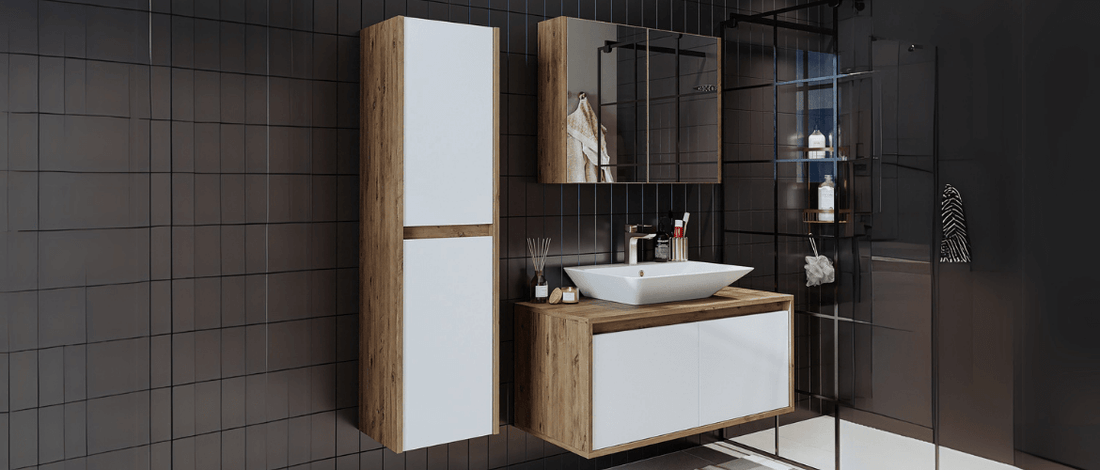
Bathroom furniture Suitable types of wood and their possibilities
Wood in the bathroom? For a long time, this was considered too risky - too sensitive, too susceptible to moisture. However, modern processing techniques and the right choice of wood species make wooden bathroom furniture not only possible, but also extremely popular. They bring warmth, naturalness and style to the often cool room. However, not all wood is suitable for damp rooms. In this article, you will find out which types of wood are particularly suitable for bathroom furniture, how they should be treated and how you can get the best out of their natural character.
Solid wood or wood decor? Differences and advantages in the bathroom
Before choosing the type of wood, there is one fundamental question: real wood or imitation?
Solid wood stands for naturalness, durability and individuality. Every piece of furniture is unique. It regulates humidity and brings a warm atmosphere into the bathroom. However, it is more maintenance-intensive and must be well sealed to withstand moisture.
Veneered furniture consists of a carrier board (usually MDF) with a thin layer of wood. They combine the natural look with better dimensional stability - ideal for changing temperatures and high humidity.
Wood decor or melamine coatings imitate the look of wood, are extremely easy to clean and resistant to moisture. They offer a wide variety of designs and are less expensive. The disadvantage: the feel is often less high-quality.
Conclusion: If you don't want to do without real wood, you should pay attention to high-quality workmanship and sealing. For easier-care alternatives, veneer and decor are a good choice - especially in heavily used family bathrooms.

Oak, teak & co.: Which types of wood are suitable for the bathroom?
Not all wood can withstand the challenges of a bathroom. Moisture, splashing water and temperature fluctuations require special properties. Here are the best types of wood for use in the bathroom:
Oak is particularly robust, hard-wearing and durable. Due to its high tannic acid content, it is naturally relatively resistant to moisture. Its subtle grain makes it versatile - from modern to rustic.
Teak woodoriginally known from shipbuilding, is a real wet room wonder. Its natural oils make it extremely water-repellent and dimensionally stable - ideal for stylish bathroom furniture.
Bamboo is technically not wood, but a grass - but an extremely stable one. It grows back quickly, is ecologically sustainable and surprisingly resistant to moisture.
Walnut brings depth and elegance to the bathroom. The dark, elegant wood looks particularly sophisticated in combination with light-colored tiles or matt surfaces. Important: good sealing is a must here.
Beech is less resistant to moisture, but can also be used in the bathroom with the appropriate surface treatment - ideal for lovers of light wood tones.
Tip: When buying, look for the note "suitable for damp rooms" - not all suppliers supply surfaces treated accordingly.
Wood protection in the bathroom: sealing, varnishes and care instructions
Wood in the bathroom needs protection - otherwise it will quickly lose its beauty. Moisture can lead to swelling, discoloration or even mould. The right treatment is therefore crucial.
Oils and waxes preserve the natural look of the wood and are ideal for solid wood fans. They penetrate the pores and protect from the inside out. Disadvantage: They need to be retreated regularly.
Lacquered surfaces form a closed layer on the wood and offer good protection against water. High-quality acrylic lacquers are resistant to moisture and durable. However, the natural look is somewhat lost.
Glazes are a mixture of protection and naturalness - they penetrate but leave the wood structure visible. Perfect for a rustic look with function.
Care tip: Even treated wood does not like standing water. Always wipe off water quickly, ventilate regularly and avoid waterlogging. Use mild cleaning agents to avoid damaging the surface.
Remember: with a little care, wood in the bathroom remains beautiful for many years - and often develops even more character in the process.

Design ideas with wood: from rustic to modern
Wood goes well with almost any interior design style - even in the bathroom. The choice of wood type, surface and design language determines the mood the room radiates.
Rustic bathrooms rely on untreated or roughly brushed surfaces, visible knotholes and strong grains. Ideal in combination with natural stone or matt fittings.
Scandinavian-bright furnishings work with light-colored wood such as birch or ash, combined with white fronts and simple lines. This creates a fresh, friendly and airy effect, especially in small bathrooms.
Industrial looks are created using dark wood types such as walnut or smoked oak, combined with metal frames, black fittings and concrete-look tiles.
Minimalist-modern with clear lines, handleless fronts and a calm wood grain. Oiled oak or veneered surfaces in shades of gray or sand are ideal here.
Tip: Mix wood with other materials - such as glass, ceramic or concrete - to create exciting contrasts. This way, the bathroom doesn't look overloaded, but stylishly balanced.
Sustainability & origin: what you should look out for when buying
Wood is a natural product - and therefore also an issue of responsibility. Anyone buying wooden bathroom furniture should pay attention to sustainability and origin.
Certifications such as FSC or PEFC guarantee that the wood comes from responsible forestry. These seals ensure fair working conditions, the protection of forests and ecological standards.
Regional woods such as oak, beech or pine have a lower carbon footprint than tropical woods - simply because they don't have to be transported halfway around the world.
Tropical woods such as teak should only be chosen if they can be proven to come from sustainable sources. Look out for suppliers who provide transparent information about the origin.
Recycled wood or so-called reclaimed wood looks are a creative and environmentally friendly alternative - particularly popular in vintage or industrial styles.
Tip: When buying furniture, ask specifically about its origin and workmanship. If you pay attention to quality, environmental compatibility and fair production, you are not only investing in a beautiful bathroom, but also in a better future.
